
The Navy Department Library
USS Capella (AK13) & USS Alhena (AKA9) Torpedo Damage
Narragansett Bay, R.I., April 9, 1942 & South Pacific Sept. 29, 1942
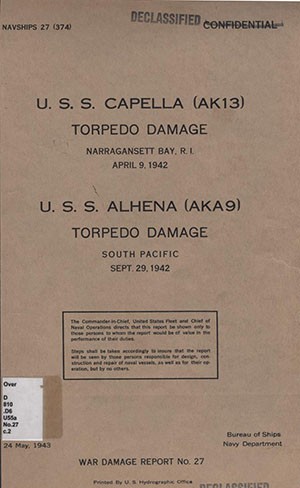
NAVSHIPS 27 (374)
CONFIDENTIAL
U.S.S. Capella (AK13)
Torpedo Damage
Narragansett Bay, R.I.
April 9, 1942
Torpedo Damage
Narragansett Bay, R.I.
April 9, 1942
U.S.S. Alhena (AKA9)
Torpedo Damage
South Pacific
Sept. 29, 1942
Torpedo Damage
South Pacific
Sept. 29, 1942
The Commander-in-Chief, United States Fleet and Chief of Naval Operations directs that this report be shown only to those persons to whom the report would be of value in the performance of their duties.
Steps shall be taken accordingly to insure that the report will be seen by those persons responsible for design, construction and repair of naval vessels, as well as for their operation, but by no others.
Bureau of Ships
Navy Department
24 May, 1943
Torpedo Damage
Narragansett Bay, R.I.
April 9, 1942
U.S.S. ALHENA (AKA9)
Torpedo Damage
South Pacific
Sept. 29, 1942
| CAPELLA | ALHENA | |
| Class | Cargo Ship | Combat Loaded Cargo Ship |
| Launched | 1920 | January 1941 |
| Displacement | 11,450 tons | 15,084 tons |
| Length (W.L.) | 390'-0" | 450'-0" |
| Beam (molded) | 54'-0" | 66'-5-1/2" |
| Draft (designed load) | 24'-0" | 27'-0" |
References:
(a) CO. CAPELLA ltr. AK13/L11/EX(170) of May 14, 1942, (War Damage Report).
(b) NOB Newport, R.I., despatch 100450NCR7231 to COM 1 of April 10, 1942.
(c) COM 1 despatch 101025NCR7719 to Opnav of April 11, 1942.
(d) C.O. ALHENA conf. ltr. AK26/A9/P2-4, Serial 09 of October 7, 1942 (Action Report).
(e) C.O. ALHENA conf. ltr. AK26/L11-1(011) of Oct. 13, 1942, (War Damage Report).
(f) C.O. NAVAJO conf. ltr. AT64/S94 of November 5, 1942.
| Section | Page | ||
| Foreword | 1 | ||
| CAPELLA Damage | |||
| A. | Narrative | 1 | |
| B. | Notes on the Explosion | 1 | |
| C. | Shock Effects | 1 | |
| D. | Indirect Structural Damage | 2 | |
| E. | Direct Structural Damage | 2 | |
| F. | Miscellaneous Damage | 4 | |
| G. | Liquid Loading Before Damage and Subsequent Flooding | 4 | |
| ALHENA Damage | |||
| A. | Narrative | 5 | |
| B. | Notes on the Explosion | 6 | |
| C. | Shock Effects | 6 | |
| D. | Structural Damage | 7 | |
| E. | Miscellaneous Damage | 8 | |
| F. | Liquid Loading in Vicinity of Hit and Subsequent Flooding | 9 | |
| Discussion | |||
| A. | General Comments on CAPELLA | 10 | |
| B. | General Comments on ALHENA | 11 | |
| C. | Comparison of CAPELLA and ALHENA Damage | 12 | |
I Torpedo Damage - CAPELLA (Profile and Section)
II Torpedo Damage - ALHENA (Profile Plan and Sections)
| 1. | Torpedo damage to starboard shell, looking aft. Note washboarding forward of rupture. |
| 2. | Torpedo damage to starboard shell, looking forward. Note crease caused by first platform. |
| 3. | Torpedo damage to starboard shell, looking aft. Note wrinkle in shell plating above rupture. |
| 4. | Torpedo damage to port shell, looking aft. Note wrinkle in shell plating between frames 159 and 160. |
| 5. | Torpedo damage to port shell, looking forward. Note tear in keel plate at frame 157 and tear in shell plating at first platform. |
| 6. | Between first platform and second deck, looking forward and to starboard from inside magazine at and over destroyed centerline bulkhead into handling room. |
| 7. | Damage inside No. 5 cargo space, looking aft and to starboard. Note damage to shaft alley plating, bulkhead 155 and bulkhead 156. |
| 8. | Damage in No. 5 cargo space after shaft alley top has been removed. Note good condition of shaft. |
| 9. | Blast damage to bulkhead 155, first platform and shaft alley top in the after end of No. 5 cargo space. Note riveted joint failures. |
| 10. | Damage to bulkhead 156 and to open flat on second deck, looking aft and to port. Note bulges in starboard side of ammunition trunk and fragment hole at foot of ladder. |
| 11. | Starboard side view of open flat. Note buckling of wire mesh bulkhead stanchion, berth stanchions, and heavy centerline stanchion. |
| 12. | Main deck, looking athwartships to starboard, at frame 156. Note bulge in main deck caused by punching action of centerline stanchion shown in preceding two photographs. |
| 13. | Damage to starboard side plating and bulwark at after end of after well deck. Note wrinkle carrying up side plating to main deck. |
| 14. | Damage to starboard bulwark at after end of after well deck. Note strained plating and crack in fair-lead. |
| 15. | Damage to port bulwark at after end of after well deck. Note fracture of bulwark along boundary angle at frame 157. |
| 16. | Torpedo damage to starboard shell U.S.S. ALHENA upon arrival in port. |
| 17. | Torpedo damage to port shell U.S.S. ALHENA upon arrival in port. |
| 18. | General view of torpedo damage. Stern has been raised considerably by shifting oil and armament forward. |
| 19. | Torpedo damage to starboard shell. Note abrupt cutting-off damage by full peak tank just aft of rupture. Also note sag of stern. |
| 20. | Blast and fragment damage to second deck, looking from port to starboard at frame 166. Bulkhead at left is the after transverse bulkhead of the trunk around No. 5. hatch. |
| 21. | Damage to shelter deck, looking aft on the starboard side from No. 5 hatch. Bow of wrecked ramp boat has been removed. Note shell plating bend back into after starboard corner of hatch. (See photo No. 19.) |
| 22. | Damage to shelter deck, looking aft from forward of No. 5 hatch. Note displaced 5-ton hatch covers and fallen 10-ton boom. Also note fragment holes in main deck. |
| 23. | Fragment damage to shelter deck directly above hit, looking from port to starboard. Stanchions were bent by bulged deck plating. |
| 24. | Shelter deck, looking forward and to port. Ten-ton boom has fallen across port 3-inch gun mount rendering it inoperative. |
| 25.
|
Looking aft and to starboard from inside No. 5 hatch at the second deck level. Note typical shear wrinkles in bulkhead at left. Also note shell plating bent 12 feet into hold. |
| 26. | Damage to crew's quarters starboard side second deck, looking aft from forward edge of No. 5 hatch. Damaged bulkhead on right is starboard bulkhead of No. 5 hatch trunking. |
| 27. | Crew's quarters port side second deck, looking forward from abreast after end of No. 5 hatch. A fire burned for 3-1/2 hours in this space. Considerable debris had been removed before photo was taken. |
1. The reports of damage to U.S.S. CAPELLA and U.S.S. ALHENA, although damaged at different times and in different geographic locations, have been combined into one report because of the similarity of damage. Both of these ships were struck by one torpedo each on the starboard side of the shaft alley recess about 27 feet forward of the propeller. Structural damage to ALHENA was considerably more extensive than to CAPELLA; however, both ships had relatively the same amount of flooding. These two ships are the first cases to be studied by the Bureau of torpedo damage to cargo vessels.
2. This report is based on the data supplied with the references. Photographs of damage to CAPELLA were supplied by the Navy Yard, New York. Photographs of damage to ALHENA were supplied by the Commanding Officer. Plates were prepared by the Bureau from an analysis of the references.
3. U.S.S. CAPELLA was struck by a nearly-spent 21-inch torpedo accidentally discharged by a U.S. Navy PT boat in upper Narragansett Bay, Rhode Island. The ship was at anchor in a light load condition in fifteen fathoms of water, sea calm and weather partly cloudy. At 1824, April 9, 1942 the torpedo struck the starboard side aft at about frame 158, 15 feet below the waterline just aft of the shaft alley.
4. The torpedo warhead contained 385 lbs. of T.N.T.* A dull muffled sound was heard by the ship's force and a small cloud of blue-white smoke was emitted from the explosion, but no difficulty from fumes was experienced. No flash or flame was noticed and if any fire were started it would have been immediately extinguished by the sudden and copious flooding.
5. Shock damage was not extensive or of a serious nature. There was some breakage of bottles in the sick bay and of mirrors in the troop washroom, both of which were located on the main deck just aft of the hit.
___________
* Mark VIII, Mod. 3D, 21" torpedo.
6. Several structural failures occurred outside the immediate vicinity of the torpedo hit.
(a) At frame 60-61, just forward of the amidships superstructure, the shell plating was strained all around the ship and fractured on the port side just below the main deck. The bulwarks were also strained and cracked.
(b) The bridge and main decks each had a compression buckle of about 1/2 inch amplitude extending the entire breadth of the ship at frame 86.
(c) The bulwarks were strained and cracked at frame 117 just abaft the amidships superstructure.
7. The Commanding Officer, in reference (a), reported that the ship lifted slightly and then settled at the time of the detonation. It is believed that this damage was caused by the lifting of the stern. The compression buckle in the bridge and main decks amidships is evidence of bending stresses. The bridge deck was especially stressed due to its distance from the neutral axis of the section. The failure at the forward and after ends of the amidships superstructure is further evidence of these bending stresses.
8. The torpedo struck the starboard side at about frame 158 slightly below the propeller shaft. The breadth of the ship at this point was about ten feet, and the explosion blew through both the starboard and port shell plating. The rupture in the starboard plating was of irregular shape with fore and aft extremities at frames 154 and 162 (17-1/2 feet apart). Vertically the rupture extended from the knuckle of the flat keel to the first platform, a distance of approximately 18 feet measured along the shell plating (Photos Nos. 1 and 2). In addition to the rupture, there were plating tears extending longitudinally to frames 153 and 163, and transversely one tear extended nearly all the way across the flat keel. Severe dishing was not extensive, the extreme boundary limits being frame 162, frame 152, and the first platform. It will be noted that these boundaries are in each case the same or very nearly the same as those for the rupture. Washboard dimpling appeared principally on the forward side of the hit and extended over a distance of approximately 18 feet.
9. The rupture in the port plating was roughly circular in shape with a diameter of about 6 feet 9 inches. Its longitudinal boundaries were frames 156 and 159, while transversely it was located on and almost completely severed the port A strake (Photos Nos. 4 and 5).
10. The vertical keel was blown away between frames 152 and 158, and as the tear in the flat keel was at frame 157 the only intact structure left in way of the hit between port B strake and starboard E strake was a strip of shell plating at the seam of the flat keel and the port A strake. This allowed the after part of the ship to sag, causing deep wrinkles in the shell plating above both port and starboard ruptures (Photos Nos. 3 and 4), and also stressing bulwark platings to the point of fracture at frame 157. The damage to the ship girder was so severe in fact that if the ship had been at sea, there would have been serious danger of the stern breaking off (Photos Nos. 4 and 15).
11. The shaft alley flat was destroyed from bulkhead 156 to 160 and was badly wrinkled and deflected from bulkhead 160 to 163. Bulkhead 160 was ruptured and mangled up to the second deck. The second deck, however, was in fairly good condition, the principal damage being a buckle ten inches high at frame 159 extending the entire width of the ship. This was evidently caused by the after end of the ship dropping as mentioned in the preceding paragraph. The deck also had three fragment holes from three inches to six inches in diameter, one of which may be noted in Photos Nos. 8 and 10 just to port of the ladder on the second deck.
12. The ammunition trunk from the magazine to the poop deck at frame 158 was bulged outwards by the explosion and the watertight hatch cover blown away and lost. The inside was blackened, although the mouth of the trunk was approximately 22 feet from the explosion and the starboard shell plating and shaft alley flat were in between. This trunk was also punctured by a fragment that entered the mouth (at second deck) and passed in through the port plating.
13. The main deck was undamaged except for a local bulge and slight tear caused by the punching action of the centerline "H" stanchion at frame 156 (Photo No. 12).
14. Forward of the hit, bulkhead 155 was blown forward on the starboard side and its upper edge pulled away from the first platform making a large opening into No. 5 hold. The top of the shaft alley, which at frame 155 jogs upward to the level of the first platform and then continues on to bulkhead 156, was blown away from bulkhead 156 and also from the shaft alley port side plating for a distance of about ten feet. These two openings permitted immediate flooding of the No. 5 hold (Photos Nos. 7, 8, and 9).
15. Bulkhead 156 above the first platform showed typical shear wrinkles on the starboard side while the port side had several inches deflection and also a fragment hole approximately three inches in diameter (Photos Nos. 7, 8, 9 and 10).
16. Bulkhead 137, between No. 4 and No. 5 holds, was also deflected on the port side and a rivet was missing from the connection with the lower outboard boundary angle. There was also a slight leak in the upper part near the centerline of the ship.
17. In addition to the major shaft alley housing damage described in paragraph 14, there were minor leaks through the upper seams in way of the No. 4 hold, and also leakage at W. T. bulkhead 109 into the engine room through a damaged electrical fixture and stuffing box. These were quite small and caused no difficulty.
18. The miscellaneous damage was mostly of a minor nature and was confined to the shaft alley and engine room. The principal items of damage were:
(a) Main generators, pumps, and main thrust bearing slightly out of line.
(b) Four sections of the main shaft and the tail shaft were bent.
(c) No. 1 bearing cap broken and pedestals for main shaft bearings 6 and 7 were crushed.
(d) In the shaft alley all pipes were fractured and all electrical fixtures were a total loss.
19. (a) The liquid loading in the vicinity of the hit before damage was as follows:
(1) Tank No. 6 (inner bottom from bulkhead 156 to 145) was 100% full of fuel oil.
(2) The after peak tank was 85% full of fresh water.
(b) Cargo space No. 5 was empty except for ballast of concrete blocks (Photos Nos. 7 and 8) and the magazine contained only about a dozen 5-inch projectiles.
20.(a) Compartments flooded immediately were:
(1) Shaft alley
(2) No. 5 hold (to W.L.)
(3) 5-inch magazine
(4) After peak tank
(5) S.A. magazine (to W.L.)
(6) Dry provision storeroom (to W.L.)
(7) Inner bottom to tank No. 6
(b) Slow flooding, all of which was controlled, occurred in the following compartments:
(1) Engine room, at the rate of two gallons per minute. (Through damaged electrical fixture and stuffing box).
(2) No. 4 hold, at nearly negligible rate.
21. The ship took a list to port of 2-1/2 degrees, the cause of which is not clear, as the flooding was apparently symmetrical. An explanation would be the possible shifting of the deck cargo or ballast of concrete blocks in the hold. This list was corrected by shifting fresh water from No. 3 port deep tank into No. 3 starboard deep tank, and by pumping fresh water overboard from the port double bottom tank under the fireroom.
22. The shifting of ballast from one deep tank to another is good practice if the ship is known to have positive stability and if additional free surface is not introduced. On CAPELLA, with her ample stability, even if additional free surface is introduced, the effect on stability is comparatively minor. In general, the emptying of double bottom tanks is poor practice. The one double bottom tank emptied made no significant difference on CAPELLA as the ship was in the light load condition with GM well in excess of 4 feet. Similar practice, however, on other vessels of less stability, is dangerous.
23. U.S.S. ALHENA was struck on the starboard side by a single submarine torpedo at 2359, September 29, 1942. The ship was 20 miles south of San Cristobal Island and was zigzagging at 15 knots on a base course of 125° true. Seas were moderate with a generally east southeast wind prevailing. Sky was overcast, visibility was fair to port and poor to starboard due to haze setting in and an approaching rain squall. None of the ten lookouts saw the torpedo because of the poor visibility to starboard. The escorting destroyer MONSSEN circled to attack but no submarine was seen, and at no time was contact made with underwater sound gear.
24. The torpedo struck the shaft alley recess about frame 169. Fire immediately broke out on the second deck, port side, in the crew's quarters, G.S.K. storeroom and small stores compartment. Clothing, bedding, linoleum, cork slab and bulkhead paint burned in these spaces producing a great deal of smoke. The fire was difficult to control due to lack of access. Wrecked bunks and bins kept men from the seat of the fire (see Photo No. 27). Despite these handicaps, the fire did not spread further, and was extinguished in 3-1/2 hours. The method used was not reported but was probably by fire hose and fog nozzle. Ammunition was removed from nearby magazines while the fire was being fought.
25. An investigation revealed that bulkhead 142, between No. 4 and 5 holds, was damaged and leaking. As the ship lay with the stern to the wind, this bulkhead was being pounded so heavily by the sea that it was feared the damage might be increased to such an extent that flooding into No. 4 hold would be uncontrollable. MONSSEN was unable to tow against the strong wind and sea; therefore, in order to relieve the pounding, it was decided to try holding the bow into the wind with the engines although they had been found to be slightly stiff. Therefore, at 0706, September 30, the ship went ahead at four knots and this was gradually increased to eight. At 1530, however, the engines raced and the ship lost headway. It was assumed (correctly) that the bolts in the tail shaft coupling had failed. The engines were secured to prevent further damage. By this time, the bulkhead had been plugged and well shored. A sea anchor was put over to check the drift.
26. By daylight the following morning, the wind was calm and the sea flat. MONSSEN started towing and continued to do so until the arrival of the tug NAVAJO at 1630, October 2. NAVAJO then took over, heading for Segond Channel, Espiritu Santo, New Hebrides, where they arrived without further incident on October 7, 1942.
27. The exact size of the torpedo is, of course, not known but two types of torpedoes from Japanese submarines have been recovered. The larger of these two types has not had the explosive charge weighed, but it is estimated from the size of the warhead to contain about 550 pounds of hexa. The smaller type contains only 385 pounds of hexa. It appears to the Bureau, in light of the damage caused, that the larger of these two types was probably used against ALHENA.
28. The explosion was reported to be heavy but muffled, accompanied by a flash out the port side and through No. 5 hatch nearly masthead high. Fire was started immediately, apparently from combustible material located in the after portion of the ship. No multiple explosions were noted.
29. The shock damage was not extensive or of a serious nature. The porcelain insulation in back of the steering engine pump motor starting panels was shattered, two arc shields on the after capstan power panel were broken, the bearing assembly of the gyroscope was dislodged, and some small copper jumpers connecting fuse clips with switches in Navy Standard Switch Boxes failed causing loss of general lighting in the vicinity of No. 5 hold. No breakers tripped, and there was no damage in the engine room.
30. The rupture in the starboard plating extended from the inner bottom to just above the second deck and from frame 164 to 176. This makes the opening approximately 25 feet long by 35 feet high (measured along the shell plating). The plating at the edges was bent inboard as much as 12 feet and in some places curled through 180° (Photo No. 25). In addition there was severe dishing in the form of a "V" from the rupture to the keel, and a vertical split in the plating down the center of the "V". Above the rupture there were two wrinkles, one just forward of bulkhead 176 and the other at frame 167.
31. The rupture in the port plating had the same vertical extent and forward boundary as the starboard rupture, but extended aft only to frame 172. This makes the opening 19 feet long and 35 feet high. In addition there was an eight-foot longitudinal tear at the forward edge. Above the rupture there were two wrinkles corresponding with those on the starboard side. These wrinkles were evidently caused by a slight sagging of the stern (Photo No. 18).
32. The torpedo apparently struck just below the shaft alley flat destroying it from frame 164 to frame 176.
33. The second deck was ruptured and raised a maximum of five feet with the deflection extending from frame 159 to bulkhead 176, and from the starboard shell to ten feet inboard the port shell. In addition the remnants of the deck in this area were riddled with fragments (Photo No. 20) evidently from the shaft alley flat and flared shell plating. All the beams were sheared and knocked upwards; some of the longitudinals tore bulkhead 176 when they pulled away, but this was the only damage suffered by that bulkhead.
34. The shelter deck was not ruptured, but was deflected a maximum of two feet, and punctured by numerous fragments some of which made holes three feet long. The damaged area corresponded closely to that of the second deck, except that it was cut off aft by the tonnage well.
35. The non-watertight forward bulkhead of the tonnage well was deflected aft, evidently by a combination of direct blast effect and lifting of the second deck. This damage was augmented by fragments which punctured the bulkhead and continued on through the tonnage hatch. It was fortunate that the fire which started just forward of this bulkhead did not penetrate it as the paymaster's stocks of paint, turpentine, etc., were stored in the tonnage well. If these had been ignited the fire might have spread to the three-inch magazine which is located just aft of the tonnage well.
36. The after bulkhead of the No. 5 hatch trunking between the second and shelter decks was deflected forward and punctured in several places. Part of this bulkhead is shown at the left in Photo No. 20.
37. The longitudinal bulkheads of this trunk were both deflected outboard as the hatch is about 10 feet wider than the ship at the estimated point of torpedo impact. The after end of the starboard bulkhead had typical shear wrinkles (Photo No. 25) evidently caused by the upward deflection of the second deck hatch coaming aft of frame 159. Whether or not the port bulkhead suffered the same type of damage is not known, but it did have fragment holes up to four feet in length.
38. The damage to the bulkhead between No. 4 and No. 5 holds (bulkhead 142) was not too severe but was potentially very dangerous, as the pounding of the sea threatened to increase the damage to such an extent that flooding through it would be uncontrollable. If this had happened the ship would probably have been lost. Most of the leakage was through an opening approximately three feet long located just above the third deck on the port side. The exact nature of this opening has not been definitely established, but it was probably caused by a fragment, as the greatest blast damage occurred on the starboard side. Here the blast effect, probably assisted by the first inrush of water, deflected the bulkhead and tore it away from the second deck. The extent of this damage is not known except that it was evidently enough to make plugging impracticable. While this damage was above the damaged waterline (Plate II) waves splashed over the top of the bulkhead until the wind and sea died down.
39. There was no damage to the main or auxiliary machinery, but damage to the shaft and its related parts eventually immobilized the ship. This damage consisted of the following items:
(a) Shaft slightly sprung
(b) Three spring bearing caps broken
(c) Failure of the bolts in the tail shaft coupling
40. The No. 5 hold hatch cover at the shelter deck was blown apart and one of the five-ton cover slabs landed on the port three-inch gun platform, one on the shelter deck (Photo No. 22) and two fell into the hold. Five of the seven heavy hatch beams are unaccounted for. A ten-ton boom tore loose from its topping lift and fell across the port three-inch gun platform, (Photos Nos. 22 and No. 24). The boom itself was slightly bent.
41. The fighting efficiency of the ship against both surface craft and aircraft was seriously impaired by damage to the armament and ammunition. This damage is listed below.
(a) Four-inch gun
(1) Mount was sprung
(2) Sights out of line
(3) All the ammunition (246 rounds) thought to be dangerous and was jettisoned
(b) Port three-inch gun
(1) Carriage sprung
(2) Elevating and training gears stripped
(3) Counterweight smashed
(4) Complete sight yoke assembly smashed
(5) Pointer and trainer seats smashed(c) Starboard three-inch gun
(1) Counterweight bent(d) 20mm gun No. 8 port
(1) Cradle cracked and sprung
(2) Cradle locking pin and spring broken(e) 20mm gun No. 7 starboard
(1) Cradle locking pin and spring broken
The guns still left in commission were two forward three-inch guns, six 20mm guns and four .50 cal. machine guns.
42. At bulkhead 176 just above the shaft alley flat, the watertight door leading into the escape trunk was blown open and slightly spring, but not enough to prevent dogging when it became accessible.
43. The emergency escape doors in both the port and starboard crew's quarters (Photo No. 26) were blown open, slightly distorted, and the frames warped, but the dogs appear to be undamaged. These doors are through the longitudinal bulkheads of the No. 5 hatch trunking and are abreast of the escape trunk (frame 165).
44. Known liquid loading was as follows:
(a) No. 5 and 6 deep tanks were both 95% full.
(b) After peak tank was 100% full of potable water.
45. (a) Compartments which flooded immediately:
(1) No. 5 hold (to W.L.)
(2) Shaft alley and shaft alley recess
(3) No. 6 port and starboard deep tanks (were 95% full of fuel oil)
(4) Emergency escape trunk (frames 176-178)
(b) Compartments where slow flooding occurred:
(1) No. 4 hold (controlled)
(2) Steering engine compartment
(3) Lucky bag
(4) Companionway (bulkheads 176-181)
46. The four-inch magazine located on the third deck starboard side, just aft of bulkhead 176, was intentionally flooded through the watertight door in the emergency escape trunk. The water leaked through the non-watertight door at the rear of the magazine (bulkhead 180) into the steering engine compartment, and from there forward again through other non-watertight doors in bulkhead 180, into the lucky bag on the port side and the companionway in the center. This flooding was augmented during the rough weather by a freak "pumping" action which worked in the following manner. With its stern to the wind the ship pitched considerably and as the stern would go down the watertight doors in the escape trunk would open and water would pour into the four-inch magazine. When the stern lifted and the water started to rush out, it would close the doors thereby trapping the water which would drain into the steering engine compartment, etc. In this manner the water level was raised about three feet. This could not be controlled at first as the bilge lines were ruptured and the submersible pumps were being used in No. 4 hold. When the submersible pumps did become available, however, the magazine watertight door was dogged and the compartments were pumped dry.
47. The flooding into No. 4 hold was controlled by two submersible pumps working 15 minutes every hour at first, and less frequently after plugging and shoring as the rate of flow dropped to approximately 200 gallons per hour.
48. The fragment damage consisted of a few isolated punctures. This is much lighter than would be expected judging from previous hits on air backed shells. For instance, a hit at the after end of the engine room on the tanker JAVA ARROW caused severe and extensive damage to the engine room forward bulkhead and skylight above. The JAVA ARROW even had one fragment hole and numerous dents in the stack. Another example is the second hit on the U.S. Navy oiler SALINAS*, in which the centerline bulkhead of empty tank No. 3 was riddled from a hit just forward of the tank forward bulkhead.
__________
* Bureau of Ships War Damage Report No. 18.
49. The increased resistance to blast effect afforded a bulkhead by liquid backing is brought out by a comparison of bulkheads 136 and 143. The former was fully liquid backed (fuel oil) and showed no damage of any kind, while the latter was air backed and although approximately 16 feet further away from the explosion than bulkhead 143, it had some deflection, a rivet missing at joint with port boundary angle, and a slight leak near the ship's centerline.
50. The stress concentration caused by a structural discontinuity is shown by the damage both forward and aft of the amidships superstructure. This damage consisted of:
(a) Strained and cracked bulwark platings both forward and aft of amidships superstructure.
(b) Partially fractured port sheer strake just forward of the bridge.
(c) Strained deck and shell plating all around the ship just forward of the bridge.
51. In ALHENA class of cargo ships the discharge manifolds, serving all double-bottom tanks aft of main engine compartment and bilge drain to No. 4 hold, are located in the shaft alley. The C.O. ALHENA on March 4, 1942 requested that extensions to these manifolds carrying forward to the main engine compartment be authorized. This requested alteration was disapproved because "the Bureau considers that the valves on manifolds in the shaft alley would become inoperative from the shaft alley only in the event that the bulkheads were ruptured, in which case ballasting that far aft would have little effect".
52. It will be noted on Plate II that the shaft alley between frames 114 and 164 was flooded due to rupture at frame 164. Due to the flooding of this shaft alley it was impossible to open the valves to permit the pumping of water from No. 4 hold and double-bottom tanks aft. Submersible pumps had to be used in No. 4 hold until the rupture could be repaired in order to prevent this compartment from filling. These pumps were also needed to pump out the steering engine room in order to permit shoring.
53. This particular case of damage is probably the one case in which a "lucky" series of circumstances took place which might have permitted the utilization of these manifold extensions. If these extensions had been present, the No. 4 tanks could have been emptied to lighten the ship aft, and the water pumped out of No. 4 hold. This would have permitted the submersible pumps to be used in emptying the steering room. This would only have resulted in getting the flooding under control sooner (ALHENA at no time was in great danger of sinking). Therefore, the Bureau again considers the installation of these manifold extensions unnecessary inasmuch as a great deal of time, labor, and material would be required to carry out this recommendation on this class of ships which, in the majority of the cases of damage, would prove of doubtful value.
54. CAPELLA was an all-riveted vessel while ALHENA was all-welded except for shell plating seams. The shell plating and frame spacing in way of the hits are very similar in both ships as shown in the following tabulation:
| SHIP | SHELL PLATE #/sq. ft. | FRAME SPACING |
| ALHENA | 20.8 to 24.5 | 2 ft. to 2-1/2 ft. |
| CAPELLA | 20.4 | 2 ft. & 2 ft. - 3 in. |
Because of their similarity, a comparison of the shell ruptures affords a good relative measure of the damaging effect of the two torpedoes. The torpedo that struck CAPELLA* could not, of course, be expected to be as destructive as the one that struck ALHENA**. Generally speaking, PT boats carry lighter torpedoes than do submarines, and the one that struck CAPELLA was the lightest of three types now carried by our PT boats. The following tabulation of shell plating damage bears out this expectation.
| SHIP | STBD. RUPTURE | PORT RUPTURE | ||
| LENGTH | HEIGHT | LENGTH | HEIGHT | |
| ALHENA | 25 ft. | 35 ft. | 19 ft. | 35 ft. |
| CAPELLA | 17-1/2 ft. | 18 ft. | 7 ft. | 7 ft. |
55. Both CAPELLA and ALHENA were hit in way of the shaft alley recess, but differences in the ships prevent an exact comparison of the internal damage. The main differences in the vicinity of the hits are as follows:
(a) Between the shaft alley flat and the second deck CAPELLA has a transverse bulkhead at the after end of the shaft alley, and a longitudinal, centerline bulkhead extending aft from this. ALHENA has no internal bulkheads in this region.
__________
* U.S. Navy - See paragraph 4.
** Presumably Japanese - See paragraph 27.
(b) ALHENA has deep tanks for fuel oil and ballast in way of No. 5 hold while CAPELLA does not.
(c) The depth of ALHENA is 54 feet, while that of CAPELLA is only 32 feet.
56. A study of the differences listed above shows that a comparison of damage to corresponding decks of the two ships can reasonably be made as the lack of a centerline bulkhead under the second deck of ALHENA would be more or less compensated for by an increase of approximately five feet in the charge distance. It will be remembered that CAPELLA suffered practically no blast damage at the second deck and no damage whatsoever at the main deck. ALHENA' second deck, however, was ruptured and deflected five feet, while the shelter deck was deflected approximately two feet. Further, the decks and interior bulkheads of ALHENA have all-welded connections. This again shows the greater effectiveness of the heavier charge.
57. Fragment damage to ALHENA, unlike CAPELLA, was as severe as in any case yet reported. The difference is, of course, partially explained by the difference in charge weight of the torpedoes. A further possible explanation could be that the torpedo that struck ALHENA probably hit just below the shaft alley flat, and being so near, destroyed it and hurled the fragments violently upwards and inboard. The torpedo that struck CAPELLA, however, is estimated to have hit about six feet below the flat, so while it was destroyed the fragments were not thrown with the same violence.
58. An interesting feature is that in spite of the differences in structural damage, the extent of flooding was practically identical in the two ships. This leads to the conclusion that in cases of torpedo damage the extent of resultant flooding is dependent on the ship subdivision and the position of the hit to almost the same degree as it is on the size of the attacking torpedo. It would be well to note here that the importance of maintaining subdivision by keeping watertight doors properly dogged cannot be too strongly emphasized. For instance, in CAPELLA, if the watertight door from the shaft alley into the engine room had been open or poorly dogged the engine room would have been immediately flooded and the ship immobilized.
59. CAPELLA and ALHENA were both able to make headway under their own power despite the proximity of the torpedo hits to the propeller shaft. It can be concluded from this that in instances of hits in this region, it is sometimes feasible to risk operating at low speeds even though some damage to shafting and shaft bearings may be known to exist. A number of cases in British experience also bear this out.
60. The propellers in both cases were undamaged. This corroborates results of small scale tests conducted by the Bureau which indicate that propellers are surprisingly resistant to the effects of an underwater explosion.
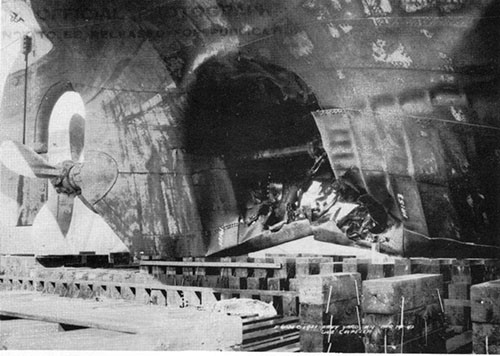
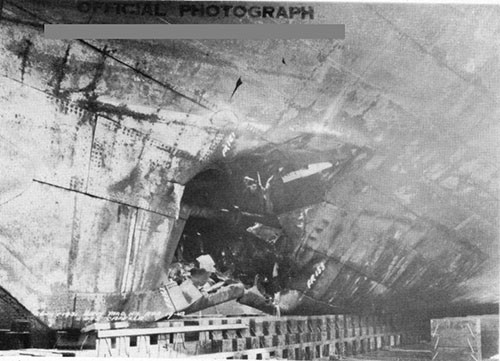
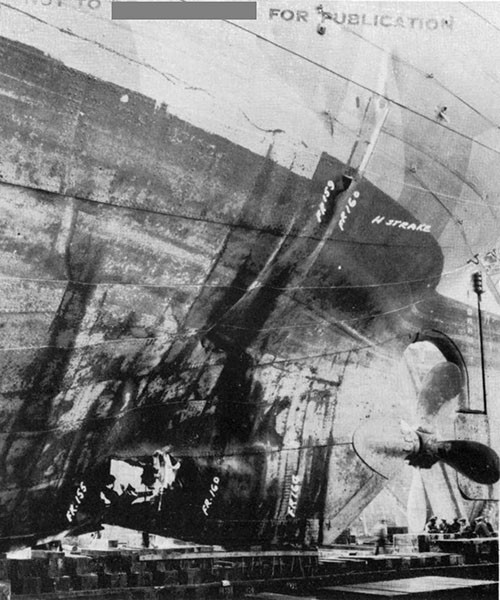
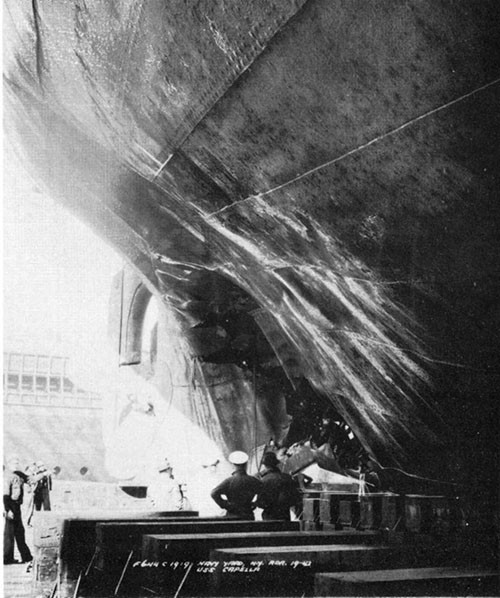
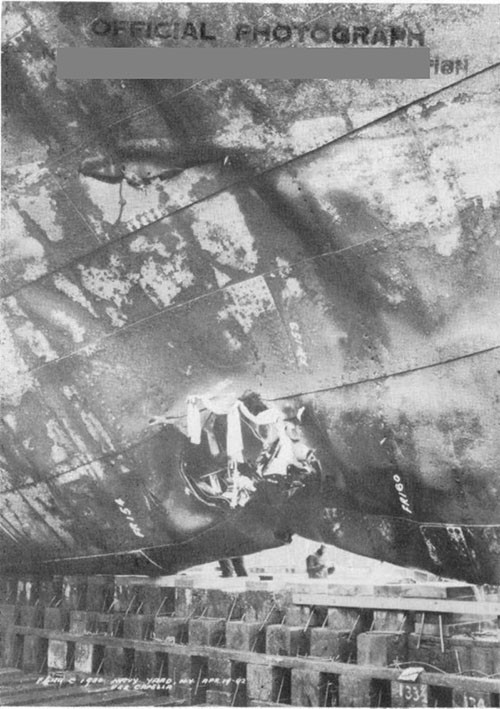
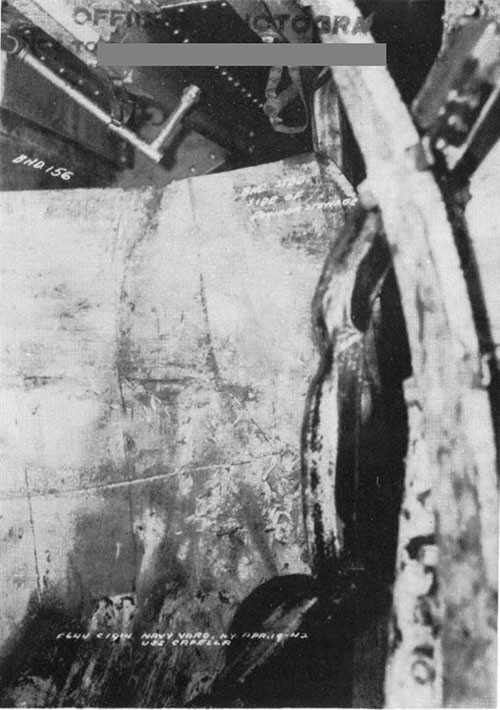
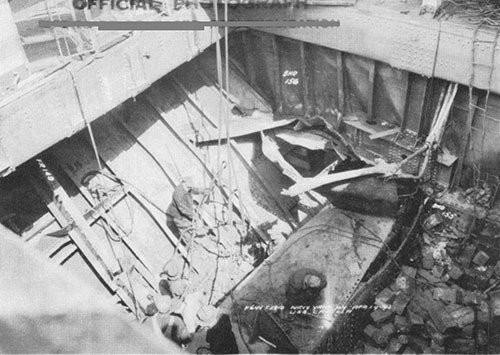
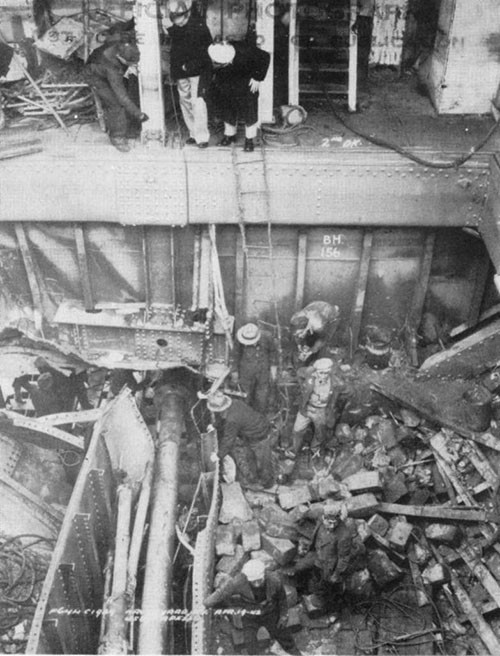
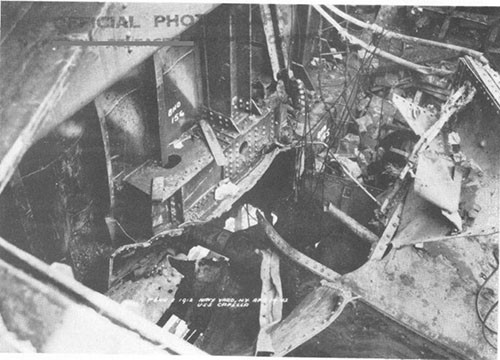
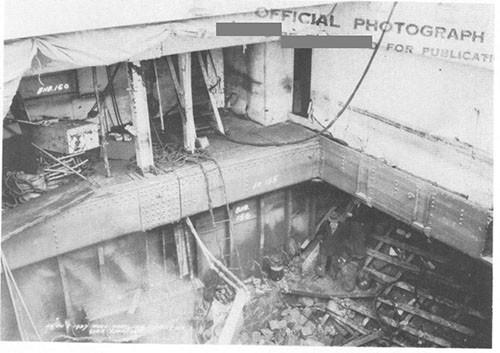
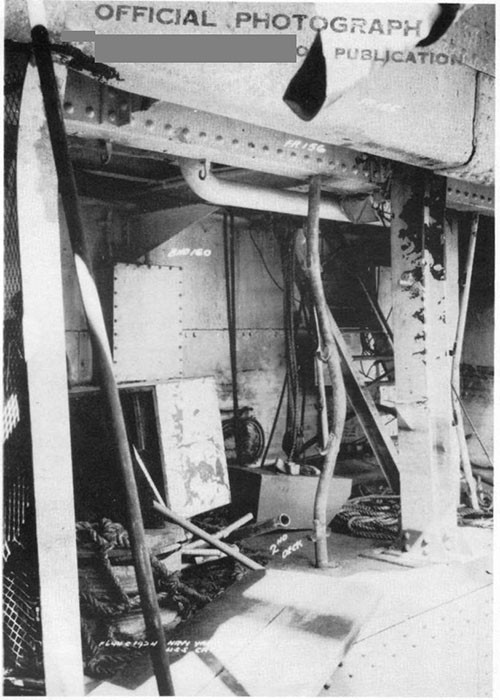
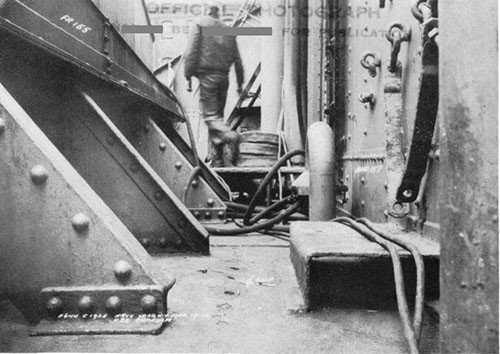
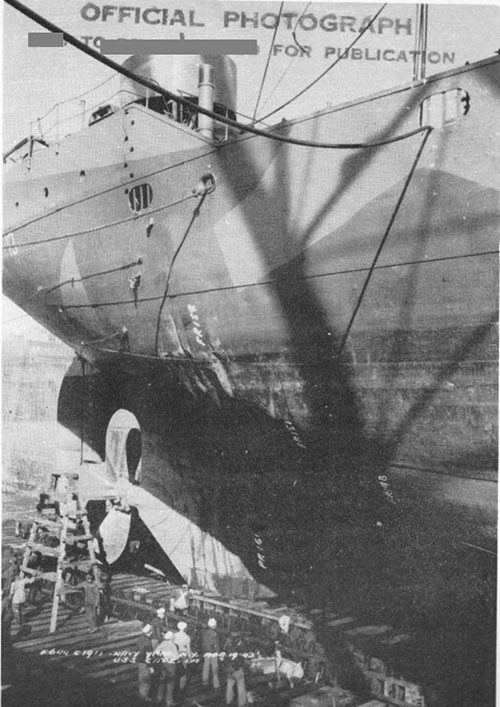
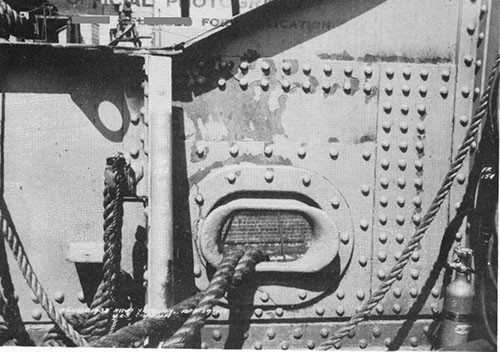
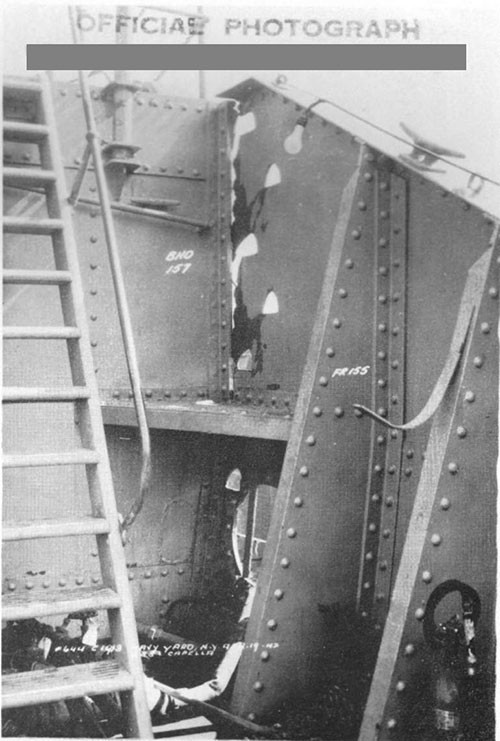
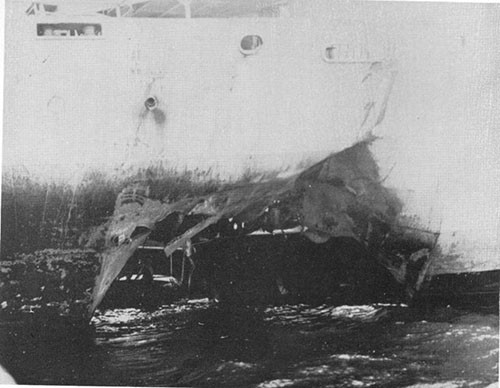
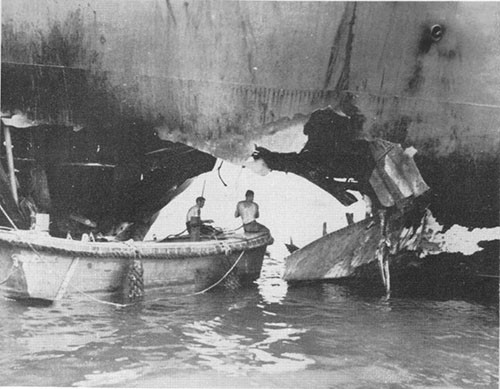
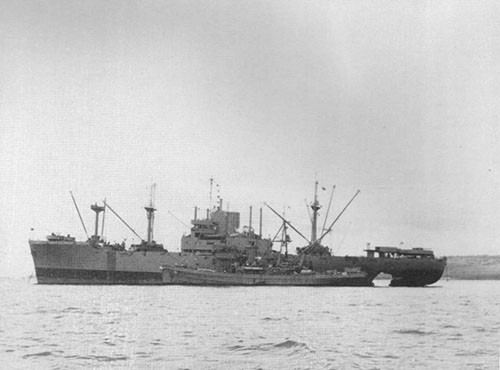
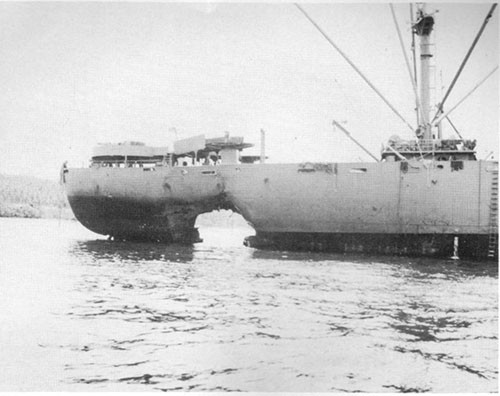
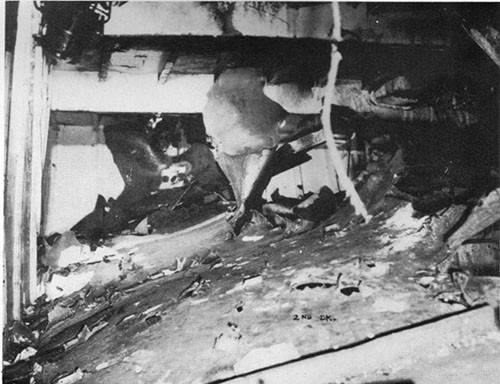
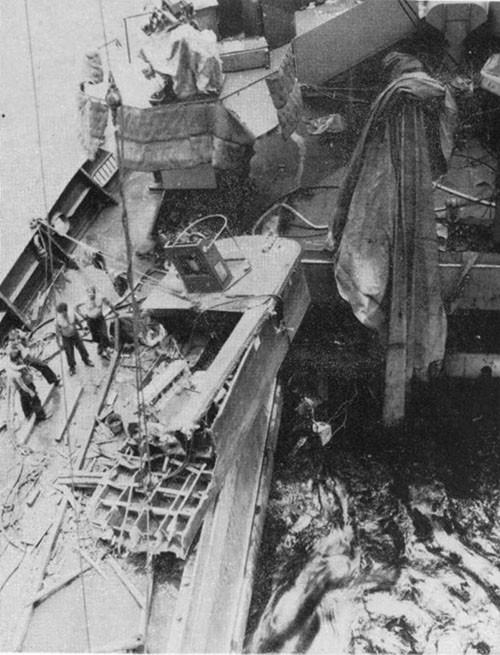
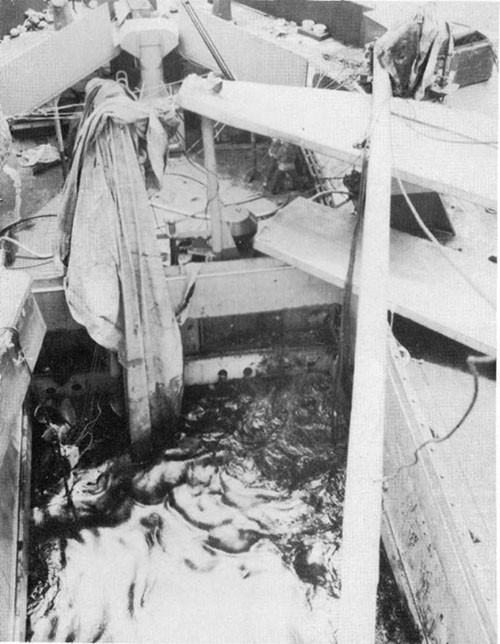
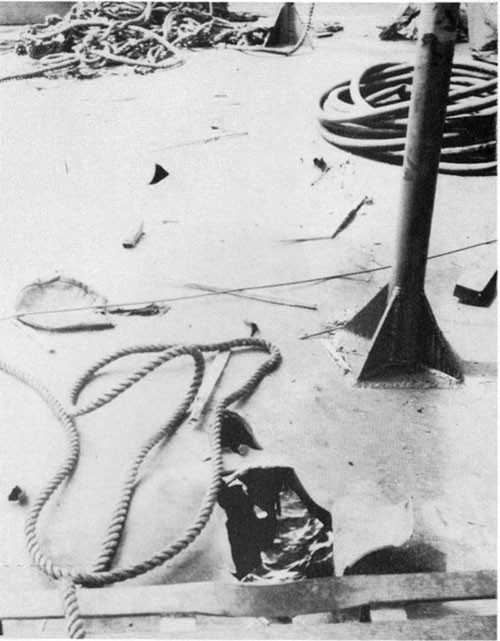
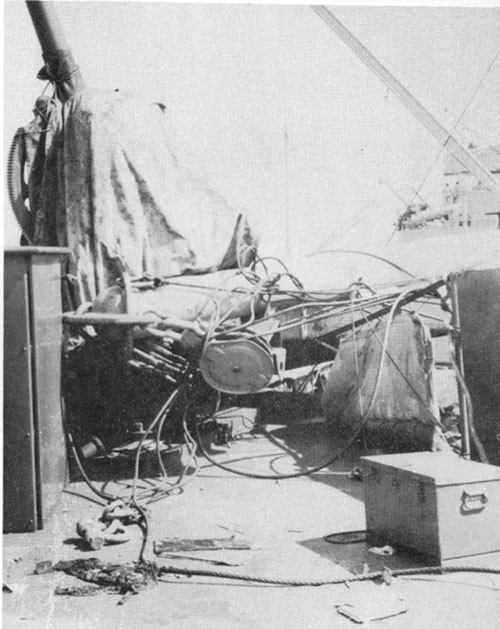
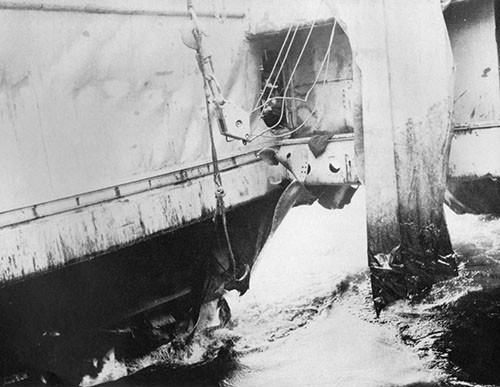
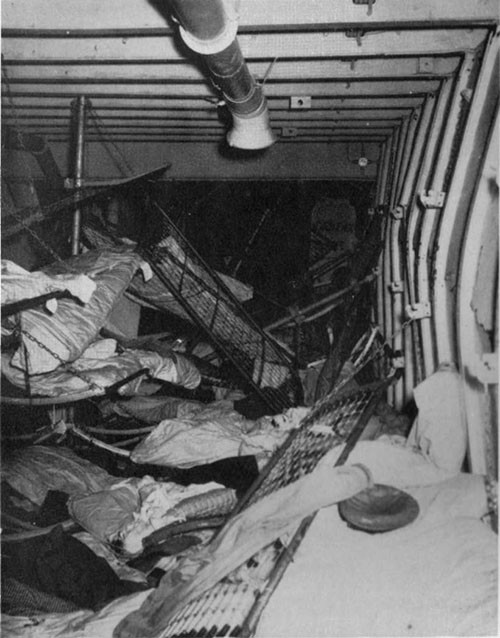
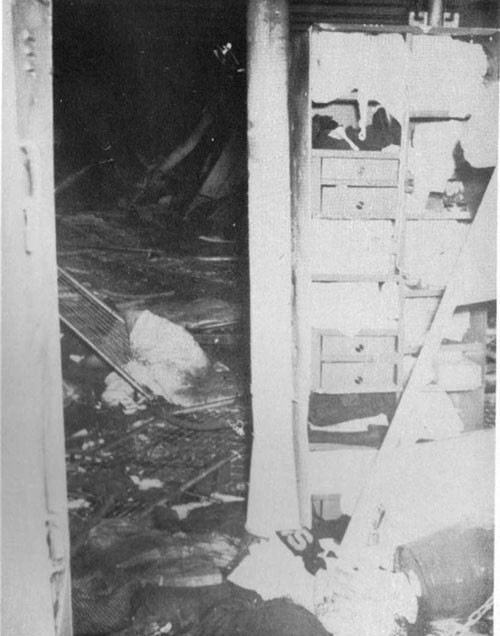
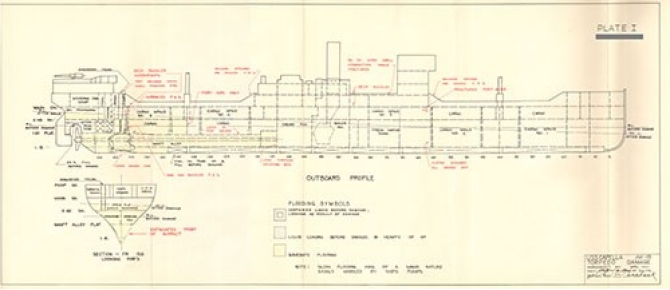
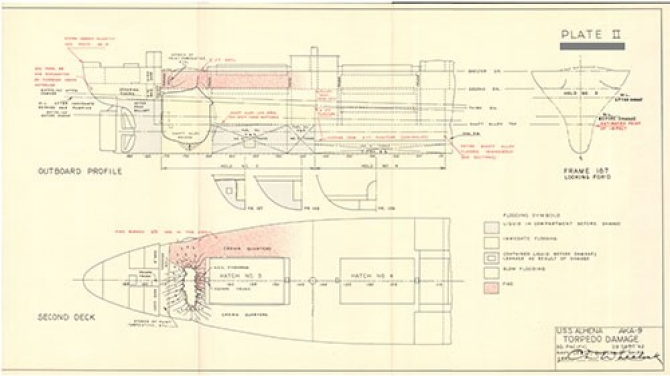
[END]



